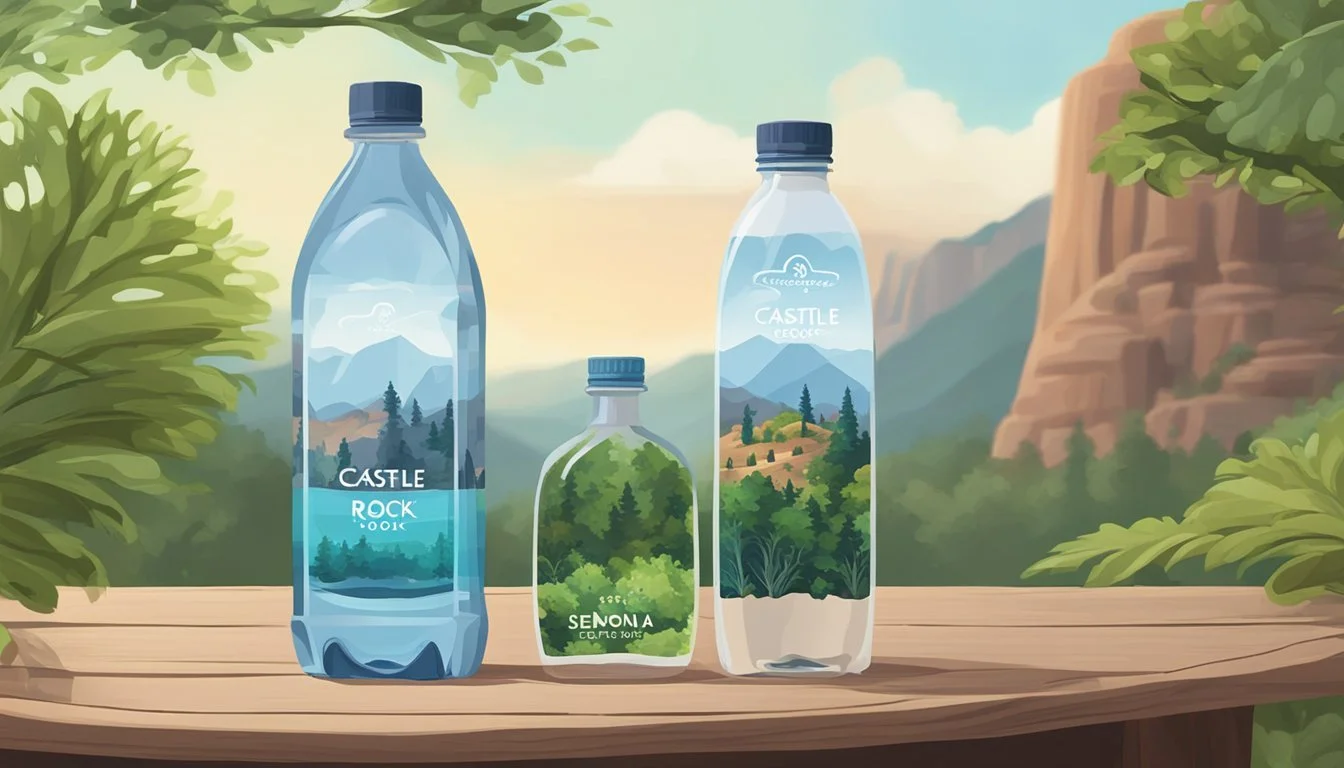Castle Rock vs. Purely Sedona
Best Bottled Water Analyzed
When choosing between Castle Rock and Purely Sedona bottled water, consumers are often faced with a choice of preference in flavor, purity, and company ethos. Castle Rock, sourced from a pristine aquifer deep in the California mountains, is celebrated for its crisp, clean taste that appeals to connoisseurs of natural water.
On the other hand, Purely Sedona prides itself on being bottled in the heart of Arizona, offering both sparkling and still options. This brand stands out for its distinct minerality and slightly tangy finish, a feature that some might find refreshing while others could consider off-putting. Castle Rock is renowned for its superior purity and natural flavor, making it a preferred option for those who value a straightforward and refreshing hydration experience.
To help consumers navigate the nuances between these two brands, this article will break down their key characteristics and benefits, enabling you to choose the bottled water that best aligns with your tastes and lifestyle preferences.
Understanding Bottled Water
To make informed choices about bottled water, it is important to examine the types available, the quality standards they must meet, and their environmental effects.
Bottled Water Types and Sources
Bottled water comes from various sources like springs, aquifers, and municipal supplies. Spring water is sourced from natural springs, while artesian water is obtained from confined aquifers. Mineral water contains naturally occurring minerals, and alkaline water has higher pH levels. Sparkling water is infused with carbon dioxide, creating bubbles, whereas still water lacks carbonation.
The source plays a critical role in the water’s taste and composition. Popular brands like Mountain Valley claim to source from pristine springs, enhancing their appeal. Knowing the source helps consumers understand the water's characteristics.
Regulatory Standards and Quality
Bottled water quality is regulated to ensure safety. In the United States, the EPA sets standards for tap water, while the FDA oversees bottled water. Standards cover contaminants, total dissolved solids (TDS), and bacteria levels.
Total Dissolved Solids levels affect taste and purity, with lower TDS indicating purer water. Bottled water must meet strict criteria to be deemed safe, including tests for contaminants like lead and chlorine. Brands often publish water quality reports to assure customers of product safety and quality.
Environmental Impact
Bottled water consumption raises environmental concerns due to plastic waste and resource use. Plastic bottles, even when recycled, contribute to pollution and require significant energy for production. Environmentally friendly options include glass bottles and the use of recycled plastic materials.
Companies like Purely Sedona use sustainable practices, attempting to reduce their environmental footprint. Consumers are encouraged to recycle and choose brands committed to eco-friendly practices, supporting a reduction in environmental impact.
Comparing Castle Rock and Purely Sedona
Castle Rock and Purely Sedona offer distinct experiences from their unique origins to their packaging, providing a range of benefits for different preferences and needs.
Origin and Source Comparison
Castle Rock is sourced from Mount Shasta in California, known for its pristine environment and natural filtration processes. This mountain spring water is bottled at the source, ensuring it retains its natural purity and mineral content.
Purely Sedona is sourced from Oak Creek Canyon in Arizona. This Artesian spring water, also bottled at the source, benefits from naturally occurring electrolytes, making it a refreshing option. Each brand prides itself on the purity and natural origins of its water source.
Taste and Mineral Content
Castle Rock water is described as having a crisp flavor, reminiscent of a mountain hike. Its clean taste is attributed to the natural filtration through volcanic rock. It is rich in minerals like calcium, magnesium, and silica.
Purely Sedona water has a slightly alkaline taste with a pH of 8. It contains bicarbonates and electrolytes, which can contribute to its smooth and refreshing flavor. Consumers appreciate the hint of natural minerals that enhance the drinking experience.
Health and Hydration Benefits
Castle Rock water offers various health benefits due to its mineral richness. High in calcium and magnesium, it supports bone health and muscle function. The presence of silica is believed to improve skin health.
Purely Sedona water, with its neutral pH and electrolytes, is excellent for hydration. The balance of bicarbonates also aids in maintaining pH levels in the body. It’s seen as a healthy option for those seeking to enhance their daily water intake with added nutritional benefits.
Packaging and Accessibility
Purely Sedona water bottles are crafted from easily recycled plastic, available in standard .5 liter and 1-liter sizes. The brand plans to introduce glass bottles inspired by small batch whiskey designs, catering to eco-conscious consumers and high-end markets.
Castle Rock uses sustainable packaging as well, focusing on minimizing environmental impact. Their water is available in various sizes, making it convenient for different needs, from on-the-go hydration to home use. Both brands are accessible in grocery stores, ensuring wide availability for consumers.
This comparison highlights the unique qualities of Castle Rock and Purely Sedona waters, from their sources to their health benefits and packaging options.
Industry and Consumer Trends
The bottled water industry has seen significant shifts towards premium options, eco-friendly packaging, and strategic branding efforts. These trends influence consumer preferences and purchasing decisions.
Rising Demand for Premium Water
Premium water brands like Purely Sedona and Castle Rock cater to consumers seeking quality and unique taste profiles. A water sommelier often highlights these brands for their distinct mineral compositions and sourcing from pristine locations.
This segment of the market has grown as individuals perceive premium water as a healthier, more sophisticated choice. High-end grocery stores like Whole Foods prominently feature these brands, reinforcing their status among discerning customers.
Shift Towards Eco-Friendly Choices
Environmental impact is a crucial factor driving the bottled water market's evolution. Consumers now prefer products with eco-friendly packaging such as 100% recyclable PET #1 plastic or boxed water.
Brands that emphasize their commitment to sustainability, by using recycled materials and reducing carbon footprints, gain a competitive edge. The efforts of companies like Purely Sedona and Castle Rock in this area resonate with environmentally conscious buyers.
The Role of Branding in Consumer Preference
Branding significantly affects consumer choices in the bottled water market. Effective branding strategies highlight purity, source authenticity, and health benefits.
Brands like Castle Rock and Purely Sedona use targeted marketing to create a distinct identity, often showcasing their natural sources and eco-focused missions. This not only differentiates them from competitors but also builds consumer loyalty.
Strategic placement in high-traffic retail locations and collaborations with influencers or water sommeliers further strengthen brand presence and consumer trust.
Analyzing pH Levels and Alkalinity
Examining the pH levels and alkalinity of Castle Rock and Purely Sedona bottled water can reveal crucial differences in their taste and health benefits. Both brands aim to offer a pleasant drinking experience while maintaining an ideal pH balance.
Importance of pH Balance in Water
The pH level of water measures its acidity or alkalinity on a scale from 0 to 14. Water with a pH of 7 is neutral. Below 7 is acidic, and above 7 is alkaline. The ideal pH for drinking water is between 6.5 and 8.5.
Balanced pH levels are essential for taste and overall health. Alkaline water is believed to neutralize acid in the bloodstream, which may benefit those with acid reflux or sensitivities. Conversely, acidic water can have a metallic taste and potentially harmful effects if consumed regularly.
Comparison of Castle Rock and Purely Sedona pH
Castle Rock: Known for its crisp flavor, Castle Rock spring water's pH level is typically within the optimal range. Though specific values aren't provided, it is often promoted as having a refreshing taste akin to natural mountain sources.
Purely Sedona: Purely Sedona sparkling water is reported to be acidic. This acidity can affect both its taste profile and potential health benefits. Consumers looking for alkaline water might find Purely Sedona's pH level less appealing.
Castle Rock offers a neutral to slightly alkaline pH level, aligning with standards for balanced drinking water. Purely Sedona's acidity could be a concern for those monitoring their dietary acidity intake. The choice between these two depends heavily on personal preference and health considerations.
Concluding Remarks on Water Selection
When selecting between Castle Rock and Purely Sedona, taste is a significant factor. Castle Rock water delivers a smooth, slightly mineral-rich flavor, catering to those who prefer a nuanced taste. Purely Sedona, on the other hand, offers a clean, crisp profile, which appeals to those who favor a refreshing and straightforward drinking experience.
Health considerations also play a crucial role. Castle Rock water, sourced from natural springs, often includes beneficial minerals yet remains free from contaminants. Purely Sedona is also reputed for its pristine source, ensuring purity and maintaining essential mineral content.
Both Castle Rock and Purely Sedona place emphasis on sustainability and environmental responsibility. Castle Rock uses eco-friendly packaging, while Purely Sedona follows rigorous standards in their bottling process, ensuring minimal environmental impact.
When choosing between these two brands, personal preference for taste and health benefits are essential. Castle Rock might appeal more to those who desire a richer mineral presence. In contrast, Purely Sedona appeals to those seeking a pure, crisp taste with a focus on maintaining optimal hydration.
For individuals with specific health concerns, reviewing the mineral composition of each brand could guide a more informed decision. Both brands offer reliable options for quality bottled water, each with distinct characteristics catering to different tastes and health priorities.



